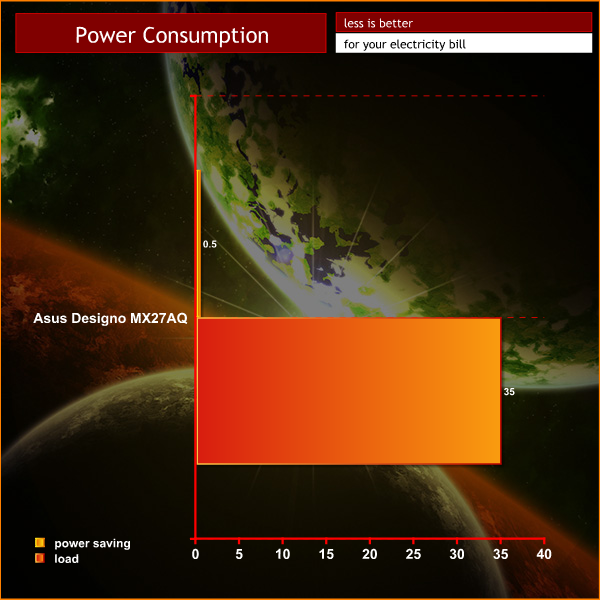To test today we are using a LaCie Calibration gun, along with specific software to accurately measure the readings. We believe this ASUS screen is using the same panel that is fitted inside the Dell U2715UH and LG ML270WQ4, although we might be wrong.
We measured Gamut out of the box and the MX27AQ returned a reading of 2.20 which is perfect. We manually adjusted Gamma to 1.8 and the panel returned a 1.81 result which is close to perfect.
The MX27AQ is a WQHD display and it features an A+ grade in-Plane switching panel with a flicker free (Direct Current Regulated) WLED backlight. The screen has a rated 109 ppi density. We measured viewing angles of 178 degrees, just as ASUS claimed, on the horizontal plane. The panel is coated with a thin, grain free anti glare finish which really helps produce a clear vibrant image, free of annoying back reflections. The colour rendition from the MX27AQ is simply fantastic and its not surprising that true 8 bit per channel colour is supported.
The Displaymate 64 step Grayscale test returned an excellent result, with only one missing step.
The Asus Designo MX27AQ ships in a reasonable state of configuration however it does benefit from a little calibration. We tweaked the contrast and brightness levels to achieve the best result. Everyone will probably end up with a different result, but it is possible to achieve great image quality with lifelike image reproduction.
Default image quality was actually close to a perfect neutral, which is unusual for an uncalibrated screen, perhaps we got lucky.
Panel Linearity rates as very good, with some very minor deviation close to the corners, and to a certain extent at all sides. Gradients are reproduced very smoothly, with only a little banding noticeable.
The screen is rated at 5MS Gray to Gray, however as this is an IPS panel there is always going to be a certain limitation apparent with the technology. As we have said before the hardcore gaming audience may find that the refresh is a little slow. Personally, I never run into issues with a 5ms refresh. I tested it with Farcry 4 and Grid AutoSport and the image quality was gorgeous at the native 2560×1440 resolution. I didn't notice any smearing either.
We would normally get second and third opinions from a local gaming clan who primarily play Battlefield but due to personal health issues I was unable to loan it out for a day.
It is worth pointing out that if you are a gamer who demands a 1ms refresh then this screen won't miraculously change your opinion.

Black Definition rates as good. Light leakage was recorded across the full width of the screen, between 5% and 7% in the central points, rising to around 16% at the far edges. In real world terms this is difficult to spot, unless you have the brightness level set close to maximum. We tested with a handful of science fiction films running at 1080p and overall image quality was excellent. We noticed that large black areas of space give an impression of great depth which indicates that light leakage is not noticeable. Rich blacks are delivered from the panel.
We measured contrast to be around 940:1 – close to the official 1000:1 static claims, which is a great result.

White purity rates as excellent – central areas rate around 6-8%. At the edges this increases to around -14%, and 16% in the extreme corners. In real world terms, images appear very bright and without any noticeable colour bias at all.
We feel this screen would make a great partner for a photographer or designer, on a budget. This isn't quite Pro Art standard, but the results are surprisingly good and indicative of a quality IPS panel.

The monitor consumes 35 watts after a little calibration, and this drops to 0.5 watts when in power saving mode.
 KitGuru KitGuru.net – Tech News | Hardware News | Hardware Reviews | IOS | Mobile | Gaming | Graphics Cards
KitGuru KitGuru.net – Tech News | Hardware News | Hardware Reviews | IOS | Mobile | Gaming | Graphics Cards


